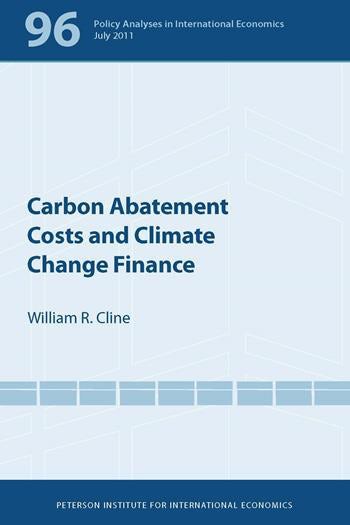This study provides alternative estimates of the costs of greenhouse gas abatement through 2050 that would be necessary to limit CO2 atmospheric concentrations to approximately 450 parts per million and limiting warming to 2°C. Specific estimates are provided for 25 major economies (with the European Union as a single economy). Business as usual baselines are first developed, based on US Department of Energy projections through 2030 and on maintenance of country-specific trends in GDP growth, energy efficiency growth, and carbon-efficiency of energy growth thereafter. The central policy simulation then involves a "Copenhagen Convergence" path, in which major economies meet their Copenhagen (December 2009) pledges for 2020, and thereafter emissions per capita decline along a path that by 2050 results in equal per capita emissions in all countries.
Three abatement cost functions are used for calculating the resulting abatement costs: a model based on McKinsey & Co. estimates for 2030; the Nordhaus RICE model cost functions; and a set of summary cost regressions calculated from the Stanford Energy Modeling Forum (EMF-22) survey of abatement models. It is found that abatement costs should be moderate, reaching about one-fourth to two-thirds of one percent of GDP by 2030 and 1 to 2 percent of GDP by 2050. Costs can be reduced by international trading, but by less than generally perceived. A more ambitious early start on abatement than pledged at Copenhagen could reduce full-period costs. The study calculates corresponding magnitudes of investment for abatement as well as adaptation costs for developing countries, and identifies a benchmark of about $80 billion annually (excluding China) by 2020, lending support to the $100 billion target pledged for industrial country financial support by that year.
- Cover
- Contents
- Preface
- Acknowledgments
- Ch 1 Overview
- Policy Context
- Method and Plan of the Study
- Principal Findings
- Ch 2 Baseline Emissions under Business as Usual
- Framework
- Decomposing Emissions Trends, 1990–2006
- Baseline through 2030
- Extending the Baseline through 2050
- Ch 3 Abatement Initiatives in the Copenhagen Accord and Cancún Agreements
- Copenhagen Accord Pledges
- Cancún Agreements
- Ch 4 Abatement Cost Functions
- Top-Down and Bottom-Up Models
- RICE Model
- EMF 22 Models
- McKinsey Model
- Ch 5 Abatement Costs through 2050
- Copenhagen Convergence (CopCon)
- Abatement Costs under the Copenhagen ConvergenceScenario
- Other Model–Based Estimates
- Alternative Abatement Paths
- Ch 6 Trade and Timing
- Shadow Price of Carbon Dioxide
- Ch 7 Estimating Investment Requirements and Adaptation Costs
- International Energy Agency
- World Bank
- Investment Levels Implied by Abatement Cost Estimates
- Adaptation
- Ch 8 Synthesis
- The $100 Billion Copenhagen Commitment
- Estimates of This Study
- Appendices
- References
- Index

